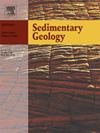Redox stratification and ecological implications of microbial dolomites in the late Ediacaran Dengying Formation, Yangtze platform
IF 2.9
2区 地球科学
Q1 GEOLOGY
引用次数: 0
Abstract
The late Ediacaran ocean witnessed a critical phase in the evolution of early life, during which redox conditions were closely linked to biological innovation. Nevertheless, the nature of these redox conditions and their interactions with evolving ecosystems remain debated. This study provides a systematic investigation of the petrographic and geochemical characteristics of microbial dolostones from the Dengying Formation on the Yangtze Platform, South China. The results reveal that microbial dolomites in this unit comprise a diverse suite of lithofacies—bioclastic, stromatolitic, oncoidal, foam-spongy, and thrombolitic dolomites—indicative of intertidal to subtidal depositional settings. Microbialite components are classified into microbial matrix, fibrous dolomite cements, and clear equant dolomite cements. Among these, Fibrous dolomite is particularly well-developed, and its cathodoluminescence zoning and length-slow optical properties suggest syn-depositional precipitation during early diagenesis. Combined δ13C and 87Sr/86Sr data suggest a warm and humid climate with high primary productivity and intense continental weathering during the Z2dn2 interval, followed by a decline in sedimentation rates during Z2dn4, albeit with continued robust carbonate deposition. All dolomite components exhibit distinct negative cerium anomalies (Ce/Ce* < 1), heavy rare earth elements (HREEs) enrichment, and elevated Y/Ho ratios, collectively indicating deposition under well‑oxygenated shallow marine conditions. Notably, the fibrous dolomite component displays the most pronounced oxidative signature, with oxygen levels at the sediment–water interface potentially approaching atmospheric values. In contrast, the clear equant dolomite cements components reflect suboxic to weakly oxic conditions, suggesting a stratified redox water column during the late Ediacaran. These observations imply that localized oxygen-rich zones on the seafloor may have developed through microbial oxygen production. When compared across the entire Ediacaran, the widespread microbial dolomites of the Dengying Formation and their associated oxic conditions likely provided key ecological niches for early benthic metazoans, such as bilaterians. The oxygenation process recorded in this formation may have played an important role in setting the stage for the Cambrian Explosion. The Dengying Formation thus captures a significant shallow-marine oxygenation event closely associated with algal proliferation and the emergence of multicellular life, underscoring the role of biologically mediated environmental feedbacks during the terminal Neoproterozoic. This study enhances our understanding of the interplay between seawater redox structure and microbial activity at the close of the Ediacaran, and supports the interpretation that microbial metabolism may have been a key regulatory mechanism in the development of oceanic redox stratification.
扬子地台晚埃迪卡拉世灯影组微生物白云岩氧化还原层序及其生态学意义
埃迪卡拉纪晚期的海洋见证了早期生命进化的一个关键阶段,在这个阶段,氧化还原条件与生物创新密切相关。然而,这些氧化还原条件的性质及其与进化生态系统的相互作用仍存在争议。本文对扬子地台灯影组微生物白云岩的岩石学和地球化学特征进行了系统的研究。结果表明,该单元的微生物白云岩包括多种岩相——生物碎屑岩、叠层石岩、锥状岩、泡沫海绵岩和血栓状白云岩——表明潮间带至潮下沉积环境。微生物岩组分分为微生物基质、纤维状白云岩胶结物和透明等白云岩胶结物。其中纤维状白云岩发育较好,其阴极发光分带和长度慢光学性质表明其在早期成岩作用中有同沉积沉淀作用。综合δ13C和87Sr/86Sr数据表明,Z2dn2期气候温暖湿润,初级生产力高,大陆风化作用强烈,Z2dn4期沉积速率下降,但碳酸盐沉积持续强劲。所有白云岩组分均表现出明显的铈负异常(Ce/Ce* < 1),重稀土元素(hree)富集,Y/Ho比值升高,共同表明沉积在富氧的浅海条件下。值得注意的是,纤维白云岩成分显示出最明显的氧化特征,沉积物-水界面的氧含量可能接近大气值。相比之下,清晰的等白云岩胶结物组分反映了亚氧-弱氧条件,表明埃迪卡拉世晚期存在层状氧化还原水柱。这些观察结果表明,海底局部富氧区可能是通过微生物产氧而形成的。当与整个埃迪卡拉纪进行比较时,广泛分布的灯影组微生物白云岩及其相关的氧化条件可能为早期底栖后生动物(如双边动物)提供了关键的生态位。在这个地层中记录的氧化过程可能在为寒武纪大爆发奠定基础方面发挥了重要作用。因此,灯影组捕获了与藻类增殖和多细胞生命出现密切相关的重要浅海氧合事件,强调了新元古代晚期生物介导的环境反馈的作用。本研究增强了我们对埃迪卡拉纪末期海水氧化还原结构与微生物活动之间相互作用的认识,支持了微生物代谢可能是海洋氧化还原分层发展的关键调控机制的解释。
本文章由计算机程序翻译,如有差异,请以英文原文为准。
求助全文
约1分钟内获得全文
求助全文
来源期刊

Sedimentary Geology
地学-地质学
CiteScore
5.10
自引率
7.10%
发文量
133
审稿时长
32 days
期刊介绍:
Sedimentary Geology is a journal that rapidly publishes high quality, original research and review papers that cover all aspects of sediments and sedimentary rocks at all spatial and temporal scales. Submitted papers must make a significant contribution to the field of study and must place the research in a broad context, so that it is of interest to the diverse, international readership of the journal. Papers that are largely descriptive in nature, of limited scope or local geographical significance, or based on limited data will not be considered for publication.
 求助内容:
求助内容: 应助结果提醒方式:
应助结果提醒方式:


